Going to the gym is fun, but what if you could bring that fun right into your own home? That's exactly what we're here to talk about today!
We understand that you already know the importance of keeping your little ones active and engaged, especially when staying home is more common. But fear not! You don't need fancy equipment or a huge space to create a Kindergym experience at home.
As gym coaches, we understand parents' pressures in balancing work, household chores, and childcare. That's why we're thrilled to offer practical tips and ideas for bringing the joy of Kindergym right to your doorstep.
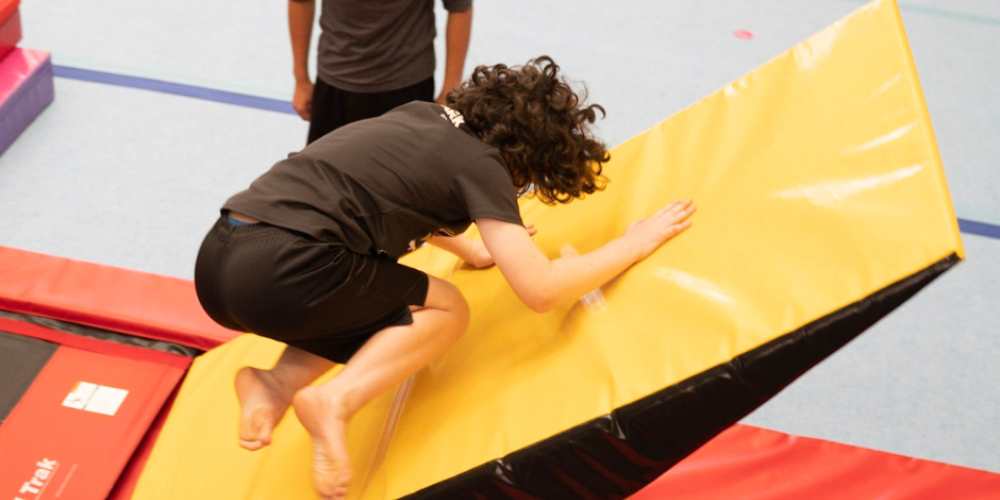
As I've said earlier, we want to encourage parents not just to leave the fun and excitement of Kindergym activities at the gym. Don't get me wrong. It's always been a pleasure for us gym coaches to see your kids thriving and having a blast in our facilities.
But why stop the fun there?
By bringing Kindergym activities into your home, you're not only providing your children an opportunity to stay active and engaged but also creating valuable moments for bonding and learning.
We all understand how crucial it is to warm up those small bodies before engaging in pleasant activities. Try a game of "Simon Says" in which you offer directions like "touch your toes" or "hop like a bunny," and your children follow along. It's a terrific way to get those muscles moving and the laughter flowing!
Turn your living room into an enormous obstacle course! Create a fun task for your children using pillows, cushions, and whatever else you can find. Make them crawl under tables, jump over pillows, and balance on a tape line on the floor. It's like having a miniature adventure park right in your own home!
It's time to put your balancing abilities to the test! Make a makeshift balance beam out of a firm surface, such as a piece of wood or a strip of tape on the floor. Challenge your children to walk heel-to-toe, bounce on one foot, or balance while collecting toys along the route. It's an excellent approach to developing strength and coordination.
Grab some scarves, ribbons, or streamers and unleash your imagination! Encourage your children to whirl, swirl, and dance around the room, discovering new rhythms and patterns. You can make it a storytelling adventure by having them act out scenes from their favourite stories or create their own.
Create sensory bins with exciting objects like rice, beans, or water. Allow your little explorers to dig in and find hidden treasures such as little toys or objects. It's an excellent method to engage their senses and pique their interest.
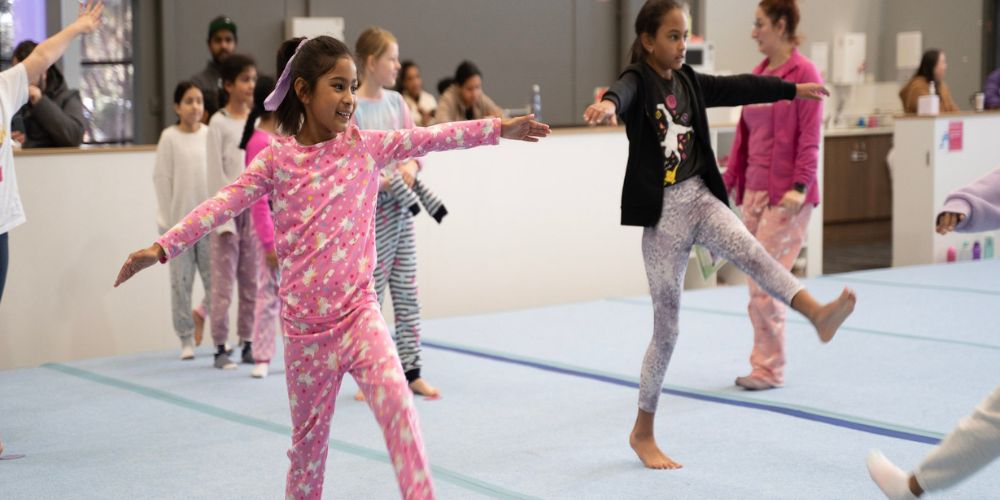
Kindergym at home is truly fun, but like any activity, it comes with its own set of pros and cons. Let's take a closer look:
Understand that Kindergym sessions at home may not always go as planned, and that's fine! Be adaptable and responsive to your child's mood, energy level, and hobbies. It's normal for your child to be uninterested in scheduled activities sometimes. Accept spontaneity and be willing to modify your plans on the fly. Being adaptable enables meaningful interactions with your child, regardless of the activity.
Involve your kid in creating and implementing Kindergym activities to foster a sense of ownership and team effort. Allow your child to help choose which activities to conduct during Kindergym sessions or aid in setting up the room. This not only gives them more decision-making authority, but it also increases your team cohesion. Working together teaches important skills such as collaboration, problem-solving, and responsibility.
Concentrate on easy, accessible activities that require little setup and equipment. You don't need expensive equipment or intricate setups to have a successful Kindergym session at home. Jumping, balancing, and crawling are all simple exercises that can help promote physical development and make the activity enjoyable. Plus, keeping things simple decreases stress for you and your child, making the entire process more enjoyable.
Recognise and praise your child's accomplishments, no matter how modest, throughout Kindergym sessions. Recognise and appreciate your child's efforts, mastering a new skill, finishing an obstacle course, or simply keeping attentive during the session. Celebrating little victories gives them more confidence and enthusiasm to continue participating in Kindergym activities.
Approach Kindergym classes with a good attitude and plenty of tolerance, especially if things don't go as expected. Remember that Kindergym is about having fun and encouraging your child's development, not perfection. Maintain a pleasant and patient attitude, even if your youngster struggles with particular activities or loses interest rapidly. Encourage, support, gently guide, and remember that development takes time.
Make safety a key priority during kindergarten classes by providing a safe environment and continuously monitoring your child. Before beginning any activity, ensure the area is safe and that any equipment utilised is robust and appropriate for the age group. Always supervise your kid, especially during climbing, leaping, or balancing activities. You can confidently enjoy Kindergym sessions by prioritising safety, knowing your kid is safe from accidents or injuries.
Yes, Kindergym activities allow children to interact with their peers, practise sharing and taking turns, and improve communication skills through cooperative play and group activities.
There are numerous online communities, forums, and social media groups where parents may share ideas, tips, and experiences about Kindergym at home. You can also get instructional videos and information from credible websites online.
One approach is to make Kindergym activities enjoyable and interesting by adding games, music, and imaginative play. You can also let your child choose the activities and give them praise and encouragement for their accomplishments.
Numerous inclusive Kindergym activities can be customised for children with special needs. Considering each child's unique needs and abilities is critical while planning activities. Consulting with a paediatric therapist or specialist may also be beneficial in developing a personalised Kindergym programme.
A kindergym at home is a fun way to keep your kids active and engaged. It provides numerous benefits for their physical, cognitive, and social development. By embracing flexibility, involving your child in the process, and prioritising safety, you can create memorable experiences that promote bonding and learning. So, clear some space, gather your supplies and prepare to embark on a journey of fun and growth with your little ones. With a positive attitude and a willingness to adapt, Kindergym at home can be a rewarding adventure for the whole family. Get ready to unleash your inner gymnast and make lasting memories together!
Have you ever heard the saying "gymnastics is for everyone"? Well, it's true! But wait, there's a tiny exception... Yep, you guessed it – our littlest explorers who are just starting to navigate the big wide world.
Don't worry if you can't picture them doing Olympic-level flips just yet. We've got loads of fun activities tailor-made for those curious toddlers, imaginative 4-year-olds, and adventurous 5-year-olds.
As the proud owner of Skylark Sports, I'm here to tell you that if you want your kids to have a blast while learning new skills, you're in the right place.
So why wait? Let's dive into the world of gymnastics together and find out some of our favourite activities to share with kids from toddlers to 5 years old.
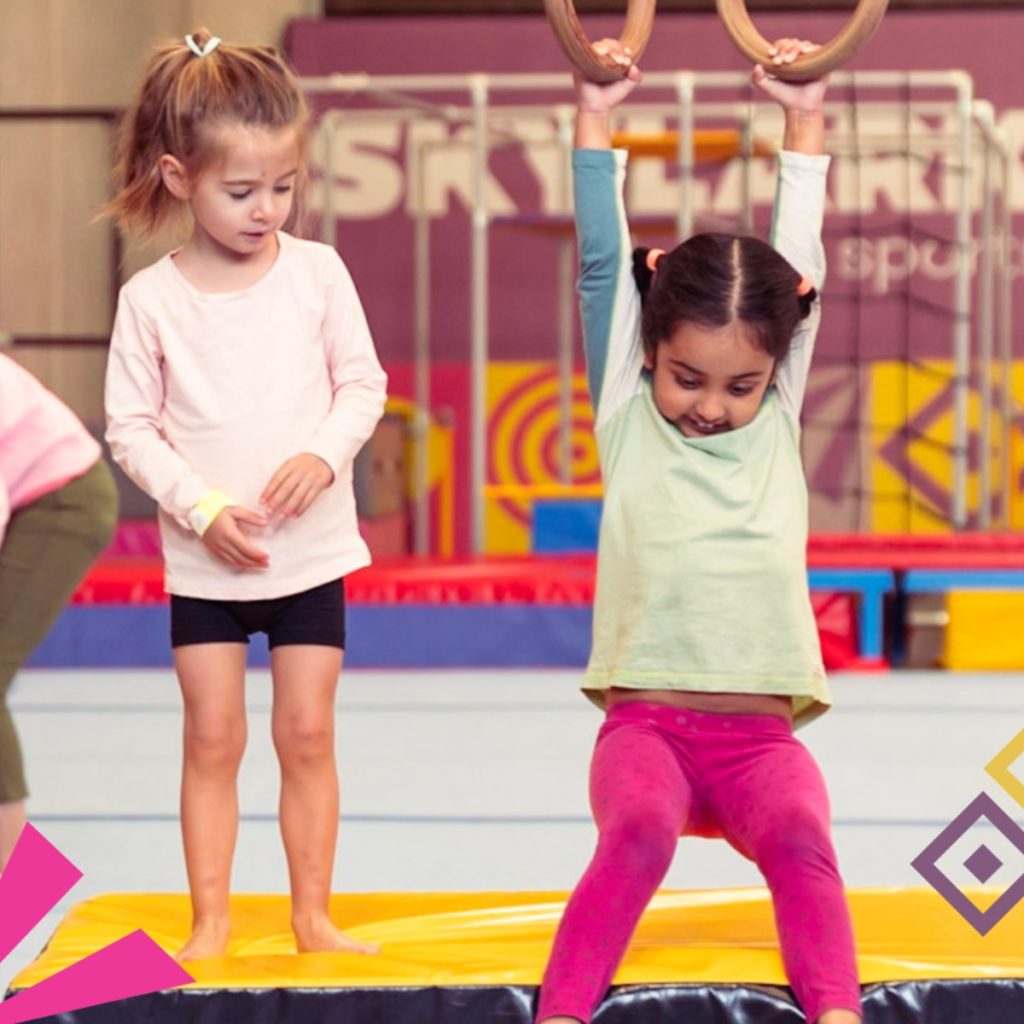
If you're going to ask me, as someone who has been doing gymnastics since I was young, it's all about the thrill of defying gravity and pushing your limits in ways you never thought possible.
Experience-wise, as a gymnastics coach, kids find gymnastics exciting because it's a perfect blend of challenge and fun.
I remember one time, this 5-year-old little guy told me he was more excited about our gymnastic sessions than his classes (which we do not encourage!).
It was heartwarming to see his enthusiasm and passion for the sport, and it just goes to show how much joy and excitement gymnastics can bring to young kids.
What age do we consider our little ones as toddlers?
Toddlers are usually considered children between the ages of 1 to 3 years old.
Toddlers are natural explorers, and gymnastics provides an excellent opportunity to tumble and play while learning important motor skills.
Here's what we do to introduce basic gymnastics moves to toddlers:
Rolling: We encourage moderate forward rolls on soft mats or cushions. This allows children to become comfortable with the action and develop body awareness.
Balancing: To help toddlers practise walking and balancing, we set up low balance beams or use masking tape to form straight lines on the floor. The goal is to increase their stability and confidence gradually.
Jumping: We provide a safe environment for toddlers to practise jumping on little trampolines or jump mats. This helps students improve leg strength and coordination while having fun!
Incorporating music and games into gymnastics activities can make the experience even more enjoyable for toddlers.
And when it comes to enhancing the gymnastics experience with fun songs and games, here's what we love to do:
Circle Time and Music: We begin each session with circle time, where toddlers can dance and move to exciting music. It gets them fired up and ready to engage in gymnastics activities.
Action Songs: We sing songs with actions like "Head, Shoulders, Knees, and Toes" or "The Hokey Pokey" and encourage toddlers to participate. It's a great method to reinforce basic gymnastics skills while keeping children engaged.
Parachute Games: We bring out a colourful parachute for activities like "Popcorn" and "Waves," which allow toddlers to jump and move in different directions. It's an excellent approach to improve coordination and social connection.
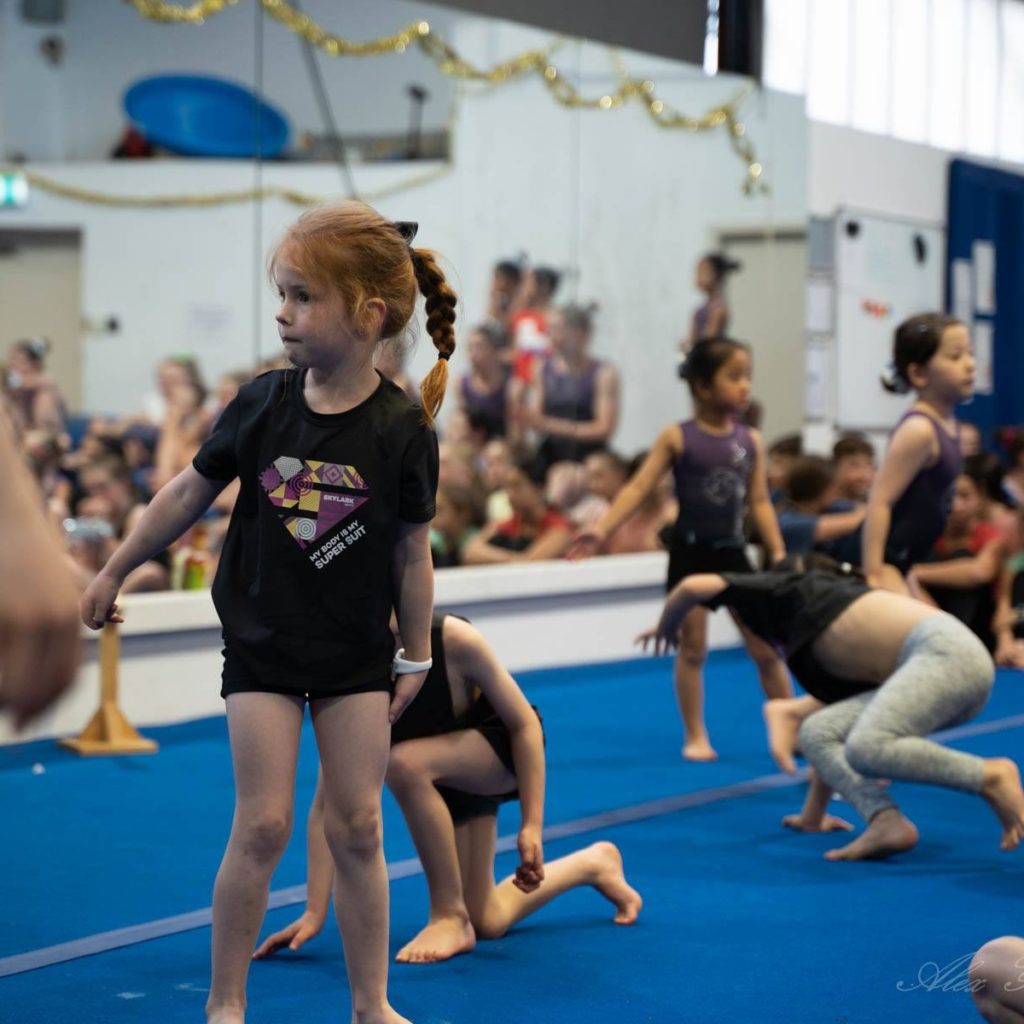
Let's talk about the awesome gymnastics skills our 4-year-old gymnasts can master!
Here's what we focus on to keep them engaged and progressing:
Forward Rolls: We focus on perfecting forward rolls, beginning with modest tucks and graduating to straight rolls. It's all about developing confidence and physical control.
Jumping: We teach a variety of jumps, such as tuck jumps and star jumps, to help children improve leg strength and coordination. Plus, it's a lot of fun to see them leap about the gym!
Balance Beam Basics: We begin with low beams and teach children fundamental balancing strategies, such as walking forward and backwards. It's an excellent approach to enhance their balance and concentration.
Now, let's talk about how we keep the fun going with group games and challenges:
Mini Gymnastics Circuits: We set up mini circuits with different stations for them to rotate through, like jumping on a mini trampoline, crawling through tunnels, and balancing on beams. It keeps them moving and engaged!
Partner Activities: We pair them for partner stretches, mirror exercises, and fun challenges like wheelbarrow walks. It's a great way to promote teamwork and cooperation while having a blast.
Creative Challenges: We encourage them to get creative with gymnastics by inventing their routines or trying new skills. It's all about fostering their creativity and confidence in a supportive environment.
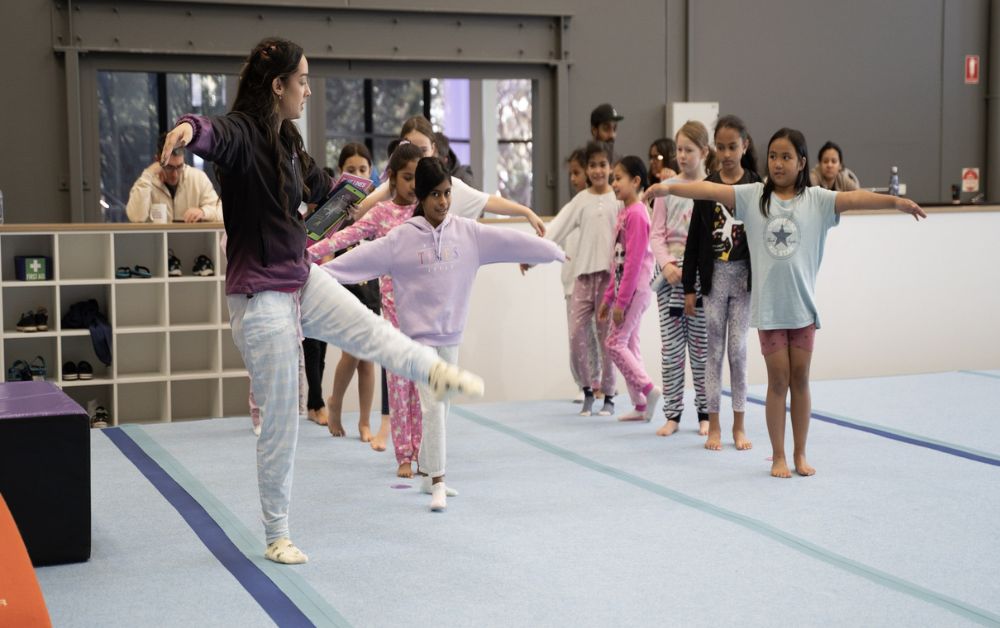
Alright, let's dive into some exciting gymnastic activities that are perfect for our 5-year-old gymnasts:
Cartwheels: We begin by teaching them how to do cartwheels and working on their strength and flexibility. It's a classic gymnastics move that always gets kids pumped!
Forward Roll to Stand: We teach a more advanced version of the forward roll, in which they roll and stand up without using their hands. It's a pleasant task that enhances coordination and body control.
Handstands: We teach them how to execute handstands against a wall, emphasising good alignment and balance. It's an excellent technique to increase upper-body strength and confidence upside down.
Beam Routines: We introduce lengthier beam routines incorporating a range of abilities, such as forward and backwards walking, kicks, jumps, and twists. It's fun to test their balance and coordination while creating a routine they'll be proud to perform.
Vault Jumps: We set up a tiny vault and taught them fundamental jumping skills, such as straight and tuck jumps. It's an exciting activity that helps children build power and explosiveness.
Safety is always a major issue in gymnastics for young children. Here are some important safety guidelines to keep in mind.
Children can begin gymnastics as early as toddlerhood. Still, it is critical to select a programme that provides age-appropriate activities and emphasises enjoyment and development over competitiveness.
Ensure your child is enrolled in a reputable gymnastics programme with qualified teachers who prioritise safety. Additionally, observe the instructors' safety advice and confirm that the gym has sufficient safety precautions.
Your child should bring a water bottle, comfortable clothing, and any necessary safety gear the gym provides.
Gymnastics classes for young children typically range from 45 minutes to 1 hour in duration.
Gymnastics is more than a sport; it is a journey of discovery and development for our children. As they navigate the exciting world of flips, jumps, and balances, kids develop physical strength, coordination, perseverance, confidence, and a lifelong passion for movement.
So let's keep nurturing their passion, celebrating their accomplishments, and marvelling as they soar to new heights, both in the gym and out. Here's to the love of gymnastics and the limitless possibilities it opens in every child!
We believe in the power of play, laughing, and making lasting memories. If you're a busy parent looking for the perfect recipe to integrate pleasure, physical exercise, and organized playtime into your child's routine, you've come to the right spot!
In this blog article, we'll dive deep into the fascinating world of gymnastics with kindergym and learn how to create a weekly calendar that easily includes these wonderful excursions. We recognize that as a parent, you seek to offer a loving atmosphere for your children that supports their growth, feeds their imagination, and fosters their social relationships.
But first, envision your child's eyes light up with delight, their laughs filling the air, and their confidence skyrocketing as they overcome each new hurdle. That is the beauty of kindergym, and we are here to assist you incorporate it into your weekly routine.
So grab a cup of coffee (or your favourite beverage) and join us as we reveal the keys to creating a weekly routine that offers delight to your child and simplifies your hectic life. Let's plan a calendar full of adventure, laughter, and fun!
Are you prepared? Let's get started!
Okay, fellow motherhood superheroes, let's plunge into the fascinating scheduling world! "Why is a proper schedule such a big deal?" you may be asking. Well, buckle up because we're about to reveal the amazing capabilities a well-crafted schedule offers you and your child.
Life can seem rather hectic, especially when balancing work, errands, and the never-ending obligations of parenthood. But don't worry; a solid timetable is your dependable partner, swooping in to bring order to the chaos. You may tame the chaos and create a quiet and predictable atmosphere for your children by following a well-structured schedule.
Time is our arch-nemesis, sliding past our fingers like a slippery eel. With a superhero-worthy schedule, though, you become the master of time! You educate your child on how to be a superhero by ensuring they have enough time for school, play, and amazing kindergym adventures. It's a talent they'll have for the rest of their life.
Including kindergym exercises into your calendar opens a world of developmental superpowers for your kid. Kindergym encourages physical development, coordination, and extremely strong gross motor abilities. You're providing your little hero frequent opportunities to flex their muscles, develop their talents, and have fun by scheduling kindergym time.
Superheroes understand the value of self-care, and a routine promotes your child's health and happiness. You make time for nutritious meals, pleasant dreams, and the rest they require to replenish their abilities. Furthermore, by incorporating good behaviours into their routine, you prepare them for a lifetime of happiness.
A well-planned timetable becomes your child's ultimate attention aid in a world full of distractions. You may build a focus fortress by allocating certain time windows for various activities, including kindergym. It's like wearing noise-cancelling headphones for your child, allowing them to delve deep into each work, learn faster, and reach their full potential.
Every superhero understands that the true superpower is the strength of familial relationships. You're organizing time when you use a timetable and generating times of true connection and affection. Family bonding time becomes precious for laughing, adventures, and creating lifelong memories.

Begin by taking note of your child's interests and talents. Do they enjoy climbing, leaping, or balancing? Understanding what fascinates children will allow you to tailor kindergym activities to their interests.
Consistency is essential! Choose and stick to particular days and hours that work best for your family. A routine gives consistency and allows your kid to expect and look forward to their kindergym adventures.
Consider your child's other obligations and duties, such as school, playdates, and family time. Find a happy medium that allows for kindergym without overburdening their schedule. Remember that the main goal is to develop a well-rounded regimen.
Take into account your child's energy levels throughout the day. Do they prefer the mornings or the afternoons? Schedule your kindergym activities during peak energy to maximize their enjoyment and involvement.
Because life is full of surprises, plan for flexibility in your child's routine. Allow for unexpected events or spontaneous experiences. It's fine to alter and adapt as necessary as the spirit of adventure and enjoyment is maintained.
Meet other families that are interested in kindergym. Join local clubs, go on playdates, and share tips and ideas. The encouragement and companionship of other parents will improve your child's kindergym experience and foster long-lasting connections.
Make time in your calendar for devoted family time. Participate in kindergym exercises, cheer them on as they overcome obstacles, and celebrate their accomplishments. Family engagement offers an added dimension of fun and enhances your relationship with your child.
As a caring mother, you undoubtedly think about the best time of the week for your children to attend kindergym sessions. I realize picking a time that works for your child's needs and your family's schedule is vital. Let me walk you through some aspects to help you make this decision with confidence:
When it comes to smaller children, such as toddlers, they frequently experience a surge of energy in the mornings. Scheduling kindergym courses earlier in the day can be a terrific way to capitalize on their natural excitement and keep them interested. Conversely, older children may have greater energy in the afternoons or nights. You know your child best, so consider when they appear lively and ready for action.
Examine your child's daily schedule to see when they have fewer responsibilities or distractions. Suppose they already have other activities or lessons on particular days of the week. Pick a day when they are more available and energized.
Some families opt to enrol their children in kindergarten sessions during the week. Because fewer participants, your child will receive more personalized attention from the instructors. However, it may be an option if both parents can join or if weekends are more convenient for your work schedules.
Remember to take your child's specific preferences and temperament into account. Some children are bright and energetic in the mornings, while others need time to warm up and become more active in the afternoons. Pay attention to their natural cycles and find a time that works for them.
It's totally fine to experiment with different time slots at first. Examine your child's activity levels, excitement, and general happiness during the courses. Based on their input and observations, you may modify it to locate the sweet spot that works best for your kid.
You should bring a water bottle for your child to keep hydrated throughout the lesson. Some programmes may ask for extra supplies such as a light snack, a change of clothing, or a towel. If there are any unique needs or recommendations, it is essential to verify with the individual programme.
It is natural for youngsters to be timid or reluctant at first. Kindergym lessons are intended to be welcoming and helpful. Experienced teachers understand how to create a friendly atmosphere and encourage children to engage at their speed. Most children gradually grow more at ease and actively participate in the activities.
The frequency with which your kid attends kindergym lessons might vary depending on their age, schedule, and personal preferences. Attending one or two weekly lessons benefits many families in terms of their child's growth and enjoyment. You may, however, pick a frequency that works best for your family's schedule and your child's degree of interest.
Parent engagement is encouraged in several kindergym programmes, particularly for smaller age groups. Participating alongside your child may improve their experience, create opportunities for bonding, and allow you to assist and support them during the activities. However, restrictions differ, so check with the individual programme for their parent involvement guidelines.
Creating a weekly calendar for your kid incorporating kindergym activities may be a joyful and helpful experience. You may create an engaging kindergym journey that fits effortlessly into your family's life by following the stages in this book and considering your child's hobbies, energy levels, and general schedule.
A good schedule is vital because it gives your child structure, regularity, and expectation. It enables children to participate in activities encouraging physical growth, coordination, social engagement, and general well-being. You can guarantee that your kid has enough time for kindergym while also considering their other responsibilities and the need for flexibility with a well-balanced plan.
So, embrace the excitement of kindergym and plan a routine that fires your child's delight, encourages their growth, and enhances your family tie. Prepare for a wonderful journey of laughter, learning, and unending fun. Happy scheduling, and have fun exploring the beautiful world of kindergym!
If you're considering enrolling your child in a gymnastics program at Skylark Sports, you may be wondering how to choose the right class. With so many options available, it can be overwhelming to decide which program is the best fit for your child. Here, we'll provide you with a step-by-step guide to help you choose the perfect gymnastics class for your child.
(more…)Early childhood education and physical development for young children are the goals of kinder gym program. This program often includes various exercises and activities catered to the unique requirements of kids between the ages of 2 and 5. A crucial element of kinder gym programmes is the child-centred approach, which is crucial for the proper development of young children.
As a mother, I always want the best for my kids, especially their social and physical growth. The importance of a child-centred approach in a kinder gym programs is one of the reasons I am thrilled to speak with you about them.
According to an article published by the Department of Education, Victoria Government, a child-centred approach means:
At Skylark Sports, our Kinder gym program emphasises children's importance and needs. Although the teachers assist in learning and growth, the children are encouraged to participate actively in their education. This method respects and builds on the children's ideas, interests, and talents.
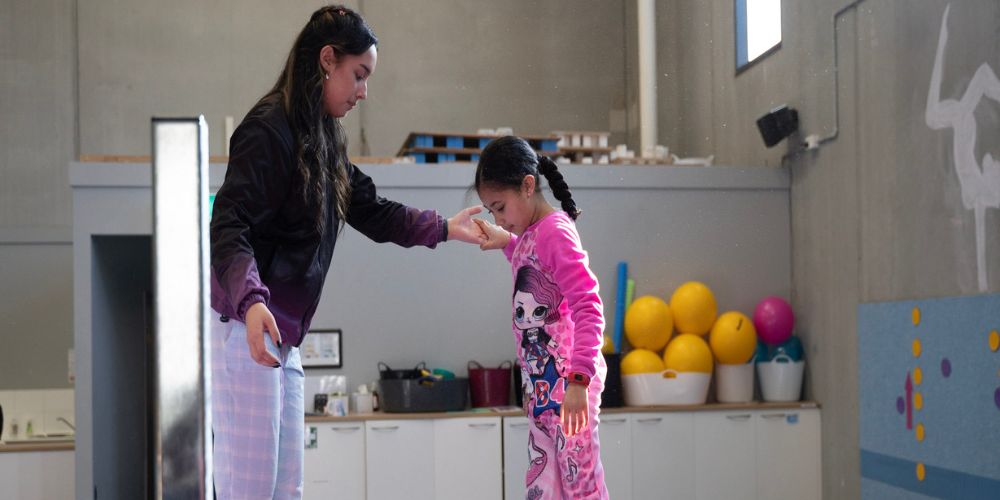
The child-centred method is a teaching concept that emphasises the student's needs and interests more than the instructor or the curriculum. This strategy is used in the Kinder Gym program by offering engaging activities that are age- and developmentally appropriate for young children. Examples of kid-friendly activities that can be included in a Kinder Gym program include as follows:
Give kids the freedom to play and explore the gym equipment without restrictions or limitations. This promotes imagination, self-expression, and creativity.
Construct obstacle courses that are difficult but doable for kids. Their coordination, balance, and gross motor abilities are all improved.
Play cooperative and team-building activities, including relay races or parachute challenges. This aids in teaching kids social skills like sharing and taking turns.
Include music and movement in the curriculum to provide kids with a platform for creative movement and dance.
I have personally seen the advantages of a kid-centred strategy in a kindergym program. Children are more interested and motivated to participate when they can actively participate in their learning and development.
Children's physical and social development depends on their active participation and engagement. Children are likelier to improve their literacy and motor abilities when participating actively. Additionally, they increase their self-esteem and sense of success.
Children have independence and self-confidence when they can explore and learn quickly. With the help of this method, kids may take charge of their education and are encouraged to participate actively.
Children are encouraged to utilise their imagination and creativity to explore new ideas and concepts through the child-centred approach. Children can use this method to express themselves in various ways, including play, music, and painting.
A child-centred approach encourages the growth of emotional and social intelligence. Children gain valuable interpersonal skills such as effective communication, conflict resolution, and connection building by working with others. Additionally, they can comprehend and control their emotions, which is crucial for their general well-being.
Each child's requirements are taken into account while using a child-centred approach. Children can study and develop at their rate in Kindergym classes, which helps them hone their strengths and conquer their limitations.
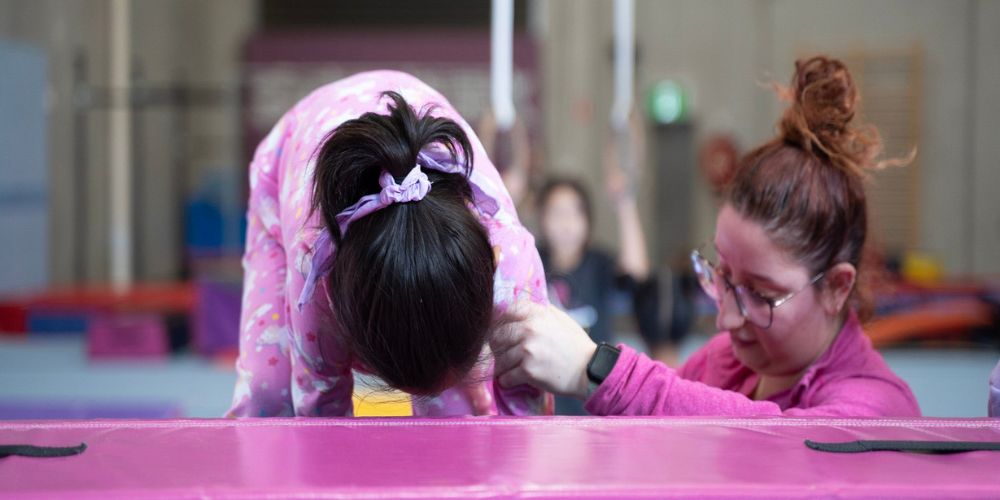
Kindergym instruction that is child-centred is crucial because it acknowledges that every kid is different and has particular needs, interests, and skills. This method aims to foster children's physical, social, emotional, and cognitive growth by establishing a secure and encouraging atmosphere where they can explore and learn quickly.
Kindergym trainers may adapt their activities and teaching strategies to match each child's unique needs and interests using a child-centred approach. Children's motivation, involvement, and sense of self-worth can all be improved by doing this. Additionally, child-centred strategies can support the development of strong bonds between students and their instructors as well as between students themselves.
Children and teenagers who engage in regular physical exercise can lower their chance of developing health disorders like heart disease, increase their cardiorespiratory fitness, grow strong bones and muscles, manage their weight, and lessen their anxiety and depression.
Running, leaping, balancing, tossing, catching, and other enjoyable activities like jumping and hula hooping are all acceptable. To help them develop their skills, resilience, and innate drive, you might encourage kids to compete against their times.
Incorporate particular opportunities for physical exercise into the daily schedule of the early years setting, like tummy time, crawling activities, or active games. Assess the indoor and outdoor spaces, and if necessary, reorganise them to provide a more open area for active play.
Children will learn to maneuver, balance, and lift objects while playing. Doing this gives them the basic movement abilities needed to maintain their physical activity throughout their lives. Physical play will support children's continued health and activity as they age. Additionally, it strengthens their muscles and bones.
A child-centred approach is critical for encouraging children's physical and social development in kinder gym programs. It promotes active involvement and engagement, self-directed learning and discovery, social and emotional intelligence development, physical literacy and gross motor abilities. We should prioritise finding programs that prioritise this approach as parents. By doing so, we can help our children develop into healthy, active, and socially competent persons.
November already!
As we slide into the final months of 2022 we wanted to update our Skylark families on what’s happening in the gym, celebrate some fantastic achievements and share some community initiatives we would love you to take part in.
(more…)This week we celebrate coach Jack, who has completed his training and is now our newest qualified coach! Coaches at Skylark complete the Skylark Coach in Training Program alongside the National Gymnastics Australia coaching qualification, ensuring your kids are in great hands.
(more…)What is it that makes some people more successful than others? Are they just born gifted with talent? Are they luckier than other people? Or maybe, it’s the way that they think…
Looking for a fun activity you can do with your toddler that builds their brains and helps them with their gymnastics? Then look no further than Animal Walks! Animal Walks is an activity that helps promote vestibular processing, engages the imagination and is lots of fun!